Cracking the New SAT with 4 Practice Tests, 2016 Edition (2015)
Part VII. Practice Tests
Chapter 21. Practice Test 1: Answers and Explanations
PRACTICE TEST 1 ANSWER KEY
Section 1: Reading
1.C
2.B
3.A
4.D
5.A
6.A
7.C
8.D
9.B
10.B
11.B
12.A
13.A
14.B
15.D
16.C
17.D
18.C
19.A
20.D
21.D
22.C
23.A
24.B
25.B
26.D
27.A
28.B
29.D
30.C
31.C
32.B
33.C
34.D
35.A
36.C
37.A
38.A
39.D
40.A
41.B
42.B
43.A
44.A
45.C
46.C
47.B
48.C
49.D
50.A
51.B
52.D
Section 2: Writing & Language
1.A
2.C
3.B
4.A
5.D
6.D
7.D
8.D
9.B
10.A
11.C
12.B
13.A
14.B
15.B
16.D
17.C
18.A
19.B
20.C
21.D
22.A
23.C
24.D
25.D
26.A
27.C
28.A
29.B
30.B
31.C
32.C
33.B
34.C
35.A
36.D
37.D
38.B
39.C
40.B
41.C
42.A
43.A
44.D
Section 3: Math (No Calculator)
1.A
2.C
3.D
4.C
5.C
6.B
7.C
8.D
9.B
10.C
11.D
12.B
13.A
14.C
15.D
16.1.5 or ![]()
17.53
18.10
19.![]() or 3.66 or 3.67
or 3.66 or 3.67
20.2
Section 4: Math (Calculator)
1.C
2.B
3.A
4.C
5.C
6.B
7.D
8.D
9.D
10.C
11.A
12.D
13.B
14.D
15.A
16.C
17.C
18.A
19.B
20.C
21.A
22.C
23.D
24.B
25.A
26.B
27.C
28.D
29.C
30.D
31.3
32.![]() or 0.83
or 0.83
33.1,279
34. or 0.384 or 0.385
or 0.384 or 0.385
35.7,054
36.63.6 or 63.7
37. or 0.7
or 0.7
38.1 ≤ y ≤ 1.25
PRACTICE TEST 1 EXPLANATIONS
Section 1: Reading
1. CThe key to this question is the phrase the passage as a whole. Choice (A) describes the purpose of a section of a passage, but is too specific to describe the purpose of the passage as a whole. Therefore, (A) is incorrect. Similarly, while the speakers briefly discuss the Shrewsbury School, the discussion occupies very little space, and is not the main point of the passage. Therefore, (B) is incorrect. Because the passage focuses on Carton, it is accurate to say that its purpose is to reveal his character. Therefore, (C) is correct. Because there is no evidence in the passage that Stryver has exploited Carton, (D) cannot be correct.
2. BBecause Stryver describes Carton as sound in the first paragraph, (A) is incorrect. Mercurial means subject to sudden changes. Because Carton rapidly changes from growling to laughing to crying, (B) accurately describes him. Carton’s luck is never described as bad, so (C) is incorrect. Because there is no indication that Carton does not notice the things occurring around him, (D) does not describe Carton.
3. AIn the previous question, it is clear that Carton’s personality and emotional state are somewhat easily changeable, so the correct answer for this question needs to reflect that theme. The quote in line 10, Up one minute and down the next, accurately illustrates the idea that Carton is mercurial; therefore, the answer must be (A). None of the other answer choices are relevant.
4. DIn the paragraph in question, in spirits describes Carton, and the paragraph says that carton is up one minute and down the next. Because despondency means depression, spirits must mean the opposite of depression, like happiness. Choices (A), (B), and (C) all mean things other than happiness. Only jubilation is the opposite of despondency. Therefore, (D) is correct.
5. AIn the paragraph in question, Stryver calls Carton unmotivated and lame, so it is clear that Stryver dislikes Carton’s behavior. Therefore, (A) is correct. Because Carton and Stryver are friends, it is clear that the description should not be taken literally; Stryver does not want to literally push Carton into the fireplace. Therefore, (B) is wrong. Similarly, the phrase the old Sydney Carton has nothing to do with Carton’s actual age but rather is a term of endearment. Therefore, (C) is incorrect. Because Stryver and Carton are presented as school friends, and there is no reason to believe Stryver ever bullied Sydney at school, (D) should be eliminated.
6. ATwo lines after the paragraph in question, Carton explicitly states that he does not find Miss Manette pretty. Because incredulity means disbelief, (A) is a good description of Carton’s attitude. Because Carton says that she is not attractive and Stryver says that she is attractive, Carton is not confused. He knows what he thinks and what Stryver thinks. Therefore, (B) is incorrect. Because there is no indication that Carton is annoyed by Stryver in the lines in question, (C) should be eliminated. Because Carton thinks Miss Manette is not pretty, he does not feel affection towards her. Therefore, (D) is incorrect.
7. CWhile Stryver says that Miss Manette is pretty, to say that he is in love with her would be extreme. Therefore, (A) is incorrect. Though Carton is not successful, Stryver says that it is a lack of motivation that holds him back, not a lack of intelligence. Therefore, (B) is incorrect. In lines 63–68, Stryver says that it looked like Carton sympathized with Miss Manette, which indicates that Stryver believes Carton was paying attention to her and saw what happened to her at court. He was paying attention because she’s attractive. Therefore, (C) is correct. Because Stryver and Carton never discuss either man’s family, (D) cannot be correct.
8. DThe answer to the previous question is that Stryver does not believe that Carton finds Miss Manette unattractive. Because the paragraphs indicated by (A) and (B) make no mention of Miss Manette, these choices are incorrect. Because the lines indicated by (C) state only that the court found Miss Manette attractive and makes no reference to Carton, this choice is incorrect. The paragraph indicated by (D) says that Carton sympathized with Miss Manette, which contradicts Carton’s assertion that she is not attractive. Therefore, (D) provides support for the statement that Stryver does not believe that Carton finds Miss Manette unattractive, and is the correct answer.
9. BBecause lifeless desert describes the whole scene, it refers to the physical landscape at which Carton is looking. Because (A) and (C) do not describe a landscape, both should be eliminated. Because Carton is looking at the city’s landscape, not sand dunes, (D) should be eliminated, leaving (B), the correct answer.
10. BBecause there is no indication of Miss Manette’s feelings, positive or negative, towards Carton, (A) is not correct. Because Carton is described as incapable and resigned, it is clear that he cannot change his behavior. Therefore, (B) is correct. Because the passage does not provide a physical description of Carton’s apartment, (C) is incorrect. Because there is no indication that Stryver is exploiting Carton, (D) should be eliminated.
11. BUse POE to find the best answer that is consistent with the passage. Since the author is in support of the revolution, (B) is a good fit. While the author doesn’t seem to support the Soviet Union in the passage, (A) is still too extreme. Eliminate (C) and (D), since the author is neither conflicted nor dismissive.
12. AUse the context from earlier in the passage, in which a secret non-aggression treaty between the Soviet Union and Nazi Germany is discussed. Therefore, look for a word or phrase that matches this description, such as “scheme.” Choice (A) is the best fit, and therefore the correct answer.
13. AThe author describes the songs as grim, but states that people had hope in their hearts. Choice (A) matches this contrast rather well. Choice (B) doesn’t work because there is no distinction made between the themes of the songs and the anthems; rather, they are both categorized collectively as having grim and sorrowful themes. The military of Estonia isn’t discussed, so eliminate (C). Song festivals are mentioned in the following paragraph, so eliminate (D).
14. BBased on the information earlier in the passage, it’s clear that Estonia wanted to be free from the Soviet Union, or to have a legal “divorce,” as stated at the end of the second paragraph. Therefore, this phrase directly correlates with this desire. Choice (B) is a good fit. Eliminate (A) because there is no mention of speaking Russian. Choice (C) is incorrect because it’s never stated that Estonia wanted to be culturally separate from other Baltic nations. Eliminate (D) because the passage implies the opposite: Estonians took the festivals very seriously, and put a lot of effort and time into them. Choice (B) is the best answer.
15. DBased on the tone of the entire passage, the size of the amphitheater is used to show how much support this revolution had. Choice (D) matches this tone well. Choice (A) is not correct because the question asks for the purpose of this fact, and this answer does not address the purpose of including this statistic. Choice (B) is also incorrect because the author is not trying to show the popularity of the Soviet Union and its leaders. You can eliminate (C) because no comparison is made to other theaters in the passage. Choice (D) is the best answer.
16. CCross out the word burden and replace it with your own word that is consistent with the text. The paragraph begins by stating that historians were defying “free speech,” but that later it was musicians that needed to do this. So a good replacement for burden would be “authority” or “leadership.” Choice (C) is the best match for this.
17. DThe final paragraph states that the revolution was powerful and that sedition hung in the wind, so find an answer choice consistent with these descriptions. Choice (A) is incorrect, as “dread” is too extreme and there were positive outcomes from the revolution. Eliminate (B) because disagreement among revolutionaries is discussed. Choice (C) is incorrect since music and poetry is too broad. It was specifically these festivals that included music and poetry that were vital. Choice (D) must therefore be the correct answer.
18. CUse POE to find an answer that is supported by information in the passage. The passage does not discuss the Soviet Union’s singing traditions, so eliminate (A). Choices (B) and (D) are directly contradicted by the passage, so get rid of them as well. Choice (C) is supported by the third paragraph that states that Estonia could not threaten the Soviet Union militarily. Choice (C) is the best answer.
19. AUse POE to find an answer that is supported by information in the passage. Choice (A) is a good match because lines 39–46 discuss the impact of the song festivals. Choice (B) is incorrect because the festival started over a hundred years ago, not during the Soviet occupation. Eliminate (C), as it’s not stated that the song festivals were unique. Choice (D) is also incorrect because the passage doesn’t discuss whether these songs were sung while working.
20. DSince the festivals were a means of demonstrating national and cultural pride, use POE to find the answer that best exemplifies this. Choice (D) is the best fit since the festivals united Estonians with poetry and music. Choices (A) and (C) are irrelevant to the festivals. Choice (B) discusses the festivals but does not mention anything about national or cultural pride. Thus, (D) is the best answer.
21. DAccording to the diagram, the Soviet Union acquired Estonia, Latvia, Lithuania, Bessarabia, and part of Poland in the pact. This land mass stretches from the Baltic Sea to the Black Sea; therefore, (D) is the correct answer. Although Germany did receive a portion of Poland, the Soviet Union also received a significant chunk. Therefore, (A) is incorrect. As depicted in the diagram, the Soviet Union is much larger than the part of Poland it acquired. Therefore, (B) is incorrect. And contiguous means sharing a common border; Lithuania and Estonia are separated by Latvia, so they are not contiguous, which means you can also eliminate (C).
22. CThe fourth paragraph states, But sir, the right to control their own Government is not one of the rights that the citizens of this country are called upon to surrender in time of war. Therefore, the author is objecting to the restrictions placed on those who have protested the war. Only (C) captures the author’s dissenting views. While it is true that LaFollette is a lawmaker, no legislation is proposed, so you can eliminate (A). Since LaFollette argues for a single point of view throughout the text, you can eliminate (B). While it is true that LaFollette was dissenting against the war, this is not his primary purpose, so you can eliminate (D).
23. AThe fourth paragraph states, …all men recognize that in time of war the citizen must surrender some…But sir, the right to control their own Government according to constitutional forms is not one of the rights…Therefore, LaFollette believes that some rights are appropriately given up and some are not. Only (A) describes this distinction. LaFollette describes free speech as a fundamental personal right and never describes a moment in which it might be unnecessary, so you can eliminate (B). LaFollette never discusses what would and would not justify a war, so you can eliminate (C). LaFollette does mention the interests of humanity (how wars are ended) and the interests of this country (enduring peace), but does not draw a distinction between them, so you can eliminate (D).
24. BThe answer to the previous choice was (A), which states that LaFollette draws a distinction between rights that are appropriately and inappropriately given up in times of war. Neither this distinction nor any other distinction is mentioned in (A), so it can be eliminated. The aforementioned distinction is mentioned in the lines referenced in (B). This is the best response. Neither this distinction nor any other distinction is mentioned in (C) or (D), so they can be eliminated.
25. BThe passage states that people are being unlawfully arrested, thrown into jail…only to be eventually discharged without ever having been taken into court. A good way to describe these individuals would be detained and separated. The only answer choice that means something similar to this is (B), sequestered. Thus, (B) is the correct answer.
26. DThe passage states that citizens must beware of those precedents in support of arbitrary action by administrative officials, which excused on the plea of necessity in war time, become the fixed rule when the necessity has passed and normal conditions have been restored. Thus, LaFollette is concerned that officials may restrict free speech during times of war but then fail to remove those restrictions when wartime has passed. More simply, LaFollette is worried that exceptions may become rules. Choice (D) matches this idea most closely. LaFollette does grant that the citizen must surrender some rights, but this is mentioned in paragraph 4. Thus, (A) can be eliminated. While LaFollette does say that some restrictions are arbitrary, paragraph 4 explicitly denies that all restrictions are arbitrary. Thus, (B) can be eliminated. While LaFollette does seem to be concerned with military action, (C) is never mentioned in the passage and can be eliminated.
27. AThe passage states that the right of the citizens…to discuss…every important phase of this war; its causes, the manner in which it should be conducted, and the terms upon which peace should be made. In this paragraph LaFollette explicitly mentions declaring war, which is referenced in (C); how to conduct war, (D); and how to end a war, (B). Thus, each of these can be eliminated. While LaFollette probably believes that citizens ought to elect legislators and executives, it is never mentioned in the passage. Thus, (A) is the best answer.
28. BThe beginning of the sentence in question states that it is the right of the citizens…to discuss…every important phase of this war. Thus, the list that follows serves as examples of the important phases of a war in which citizen oversight might be necessary. Choice (B) is the best match to this description. LaFollette’s main point in the passage is to argue against the restriction of free speech during war, so (A) can be eliminated. LaFollette does offer reasons why the press might be afraid to speak out, but not in the referenced paragraph. Therefore, (C) can be eliminated. LaFollette does not believe that citizens understand wars better than the president, only that the country needs the counsel of all citizens, so (D) can be eliminated.
29. DThe answer to the previous question is (B), that LaFollette believes that free speech is necessary for the conduct of war. Choice (D) introduces this idea explicitly. The lines in (A) reference reasons that people are currently afraid to publicly discuss the issues in question, but do not provide reasons why speech is necessary and can be eliminated. The lines in (B) explain why some are attempting to restrict speech and can be eliminated. The lines in (C) give reasons why we should be concerned by the attempts to restrict free speech, but they provide no explicit mention of why free speech is necessary during times of war. Eliminate (C) as well.
30. CThe last paragraph of the passage states that now is precisely the time when the country needs counsel of all its citizens. Therefore, LaFollette believes that attempts to stifle discussion about issues of war are highly undesirable and contrary to the major goals of American democracy. Only (C) expresses an attitude that matches this position. LaFollette does not offer any sympathetic explanations for suppressing free speech, so (A) can be eliminated. LaFollette clearly cares about the suppression of free speech, so (B) can be eliminated. Choice (D), morose, is a negative attitude, but it is overly negative and too passive for the tone of the passage. LaFollette is displeased with the suppression of free speech, but he is not sad or depressed about it.
31. CThe first sentence of the last paragraph states that It is no answer to say that when the war is over the citizen may once more resume his rights…. Thus, LaFollette rejects even the idea of a temporary restriction of free speech, a right that he calls precious and fundamental. LaFollette thinks that free speech should never be withheld. Instead it should be maintained without interruption or restriction. Choice (C) is the best match to this meaning.
32. BChoice (B) is the correct answer, since satellite photos gave evidence of the fault lines at the edges of the earth’s plates. Choice (A) is incorrect because it’s too extreme, while (C) says that the theory was created in 1965, whereas the passage indicates that there had been investigations of the theory before then. Choice (D) is too narrow, since the San Andreas Fault is used as an example, but it alone didn’t prove that plate tectonics is a valid theory.
33. CThe author states in paragraph 3 that continental-drift theory described the continents as mobile chunks that moved through the ocean floor, while plate tectonics has the continents moving with the surrounding seabed, so (C) is correct. Choice (A) is too extreme, since the continents don’t flow or stay immobile in either theory, nor do they move with or without purpose in either theory, as (C) states. Choice (D) sounds very similar to the metaphor given, but the actual distinction is the idea of plowing through versus moving in conjunction with. Thus, (D) is incorrect.
34. DThe convection currents transfer or diffuse heat from the molten rock, and this leads to the plate movements. Thus, (D) is correct. Choices (A) and (B) are incorrect, since the word convection doesn’t mean to liquefy or melt. Choice (C) is incorrect because, while the plates are moving, convection doesn’t mean to move as in a military endeavor.
35. AThe author introduces Yellowstone’s hot springs as an example of how volcanoes can exist mid-plate when hot spots push lava up through the plate, so (A) is the correct answer. Choice (B) is incorrect because it is too extreme (one example doesn’t prove anything). Choice (C) is incorrect because Yellowstone isn’t used in this passage to support an opposing theory. Choice (D) is incorrect because it’s referring to a mid-ocean ridge, which occurs at the borders of plates.
36. CThe passage says that These plumes of molten rock, often called hot spots, rise and erupt through the crust of a moving plate, implying that the hot spots are punching up through a complete piece of the crust to create volcanoes, since there’s no fracture for it to flow through. Thus, (C), As the crustal plate moves, the hot spot “punches” up a line of volcanic and hot-spring activity, is correct and you can eliminate (A), (B), and (D).
37. AThe Hawaiian Islands are consistent or on a line with the movement of the Pacific plate, so (C) and (D) are wrong, since they state the opposite. The islands are created as the plate moves, but then the plate moves on and the islands don’t change to suit it, so (B) is incorrect. Thus, (A) is the answer.
38. AChoice (A) is correct because it matches the passage, which states that Iceland was created by lava flow that bubbled up from between two tectonic plates at a mid-ocean ridge. Choice (B) contrasts an island and a continent, which the passage does not, while (C) says that the author mentions Iceland to prove that an island can be a volcano. The author never says that an island can’t be a volcano, so (C) is incorrect. Choice (D) is true, but it doesn’t answer the question. Iceland does straddle the mid-Atlantic ridge, but the reason that the author mentions Iceland is to give an example of an island that was created by lava flow at a hot spot.
39. DThe passage says that the lava flows more abundantly in certain spots, producing volcanic islands (lines 70–72) and underlie the large, highly volcanic island of Iceland, which straddles the Mid-Atlantic Ridge (lines 75–76). Thus, (D) is correct. Choices (A), (B), and (C) do not coordinate with any answers in the previous questions and are, therefore, incorrect.
40. AThe author uses the phrase Some geologists propose to show that plate tectonics are a theory, and there are still things about it that scientists don’t know and want to learn. Thus, (A) is correct. The passage never mentions a lack of data, so (B) can be eliminated, while (C) implies that the phrase is introducing an opposing viewpoint, which it does not. Choice (D) refers to the continental-drift theory, which is not part of the logic of this paragraph, so it is incorrect.
41. BThe passages states that plumes of molten rock, often called hot spots, rise and erupt through the crust of a moving plate. The diagram depicts this process with a line traveling up through the lithosphere to the surface. Therefore, (B) is correct. While the diagram does depict a continental rift zone by the ocean, there is no evidence in the graph or the passage that this is always the case. Therefore, (A) is incorrect. The passage states that mid-ocean ridges mark boundaries where plates are forced apart as new ocean floor is being created between them. So, (C) can be eliminated. There is no mention in either the passage or the diagram of the relative rigidity of oceanic and continental crust, so (D) can be eliminated as well.
42. BThe author’s main point in the first paragraph is that the construction of the Glen Canyon Dam did affect downstream resources, including the loss of large beaches used for camping and the addition of several animals to the endangered species list. Choice (B) matches the context of this passage. Eliminate (A), as no mention is made of maintaining water resources. According to the passage, the fish were adapted to the pre-dam era, so (C) doesn’t work because decimated is too extreme. Choice (D) is the opposite of what the first paragraph suggests, so eliminate it.
43. AThe correct answer to the previous question was that the dam was built with a lack of foresight. This is shown best with (A), since it’s mentioned that little consideration was given to how dam operations might affect downstream resources. Choices (B) and (D) both show consequences but don’t necessarily match the phrase little consideration, so eliminate them. Choice (C) isn’t negative at all, so get rid of it.
44. AThe passage states that the scientists and recreationists observed the physical transformation of the river in Grand Canyon, so the correct answer should match this information. Choice (A) is a good fit, so keep it. Eliminate (B), as no mention is made of casual observation, as well as (C) because the passage never hints at collaboration between scientists and the public. Choice (D) is too extreme since the passage never proves anything. Choice (A) is the best answer.
45. CThe first paragraph of Passage 1 discusses the humpback chub and mentions that it has been listed as endangered and that the dam and its operation jeopardized the continued existence of humpback chub in Grand Canyon. Choice (A) is incorrect because it’s too extreme. The chub is endangered, not extinct. Choice (B) is referring to the fish later in the passage instead of the chub, so eliminate it. Choice (D) is never mentioned, so eliminate this choice as well. This leaves (C), since it can be inferred the chub can survive a variety of environments since it’s still alive.
46. CGo to the first sentence of paragraph 2 in Passage 1 and cross out the word regime. Substitute this with your own word using the context of the paragraph. A good replacement would be “process,” so find a word that would match this. Choice (C) would fit, so keep it for now. Choice (A) is a dictionary definition of regime, so eliminate it. Choices (B) and (D) are not related to “process” in any way, so get rid of them as well. Choice (C) is the best answer.
47. BGo to the second sentence of the paragraph 2 in Passage 2 and cross out the word suspended. Substitute this with your own word using the context of the paragraph. The paragraph mentions that sand is included at high concentration in the flow, so a good replacement would be “combined.” Choice (B) is the best match.
48. CUse POE to find an answer consistent with the passage. Controlled floods are discussed in the final two paragraphs, so this should be the reference window. Choices (A) and (D) are incorrect because snowmelt is mentioned only in the first passage. While controlled floods sometimes lead to the higher concentrations of suspended sand, this is not always the case. Therefore, (B) can be eliminated. Choice (C) works since the first sentence of the final paragraph states that the floods may erode sandbars if the concentration of suspended sand during a controlled flood is too low. Therefore, (C) is the best answer.
49. DThe correct answer to the previous question deals with the negative effects of controlled flooding on the health of the river, so the answer to this question should reflect that theme. The lines referenced in (D) describe sandbar erosion, which would certainly qualify as something “detrimental,” and thus (D) is the correct answer. The lines from the passage referenced by the other answer choices do not illustrate any negative effects on the river.
50. AThe High Flow Experiments mentioned in Passage 2 refer to controlled floods used to increase sandbars. Therefore, the author of Passage 1 would have a positive attitude towards these floods because Sandbars, riverbanks, and their accompanying aquatic habitats were reshaped, which is ultimately beneficial to the ecosystem. Choice (A) is a good match for this information. Eliminate (B), (C), and (D) because each of these is too negative.
51. BPassage 1 is mostly interested in the geologic history of the Glen Canyon Dam, whereas Passage 2 primarily discusses the use of controlled floods. Use POE to find the best answer. Eliminate (A), because even though a problem is presented in Passage 1, Passage 2 doesn’t address the same problem or solution. Choice (B) is a good fit, so keep it for now. Choice (C) is pretty vague, and it’s not clear whether the changes in Passage 2 are recent, so eliminate it. No experiment is discussed in Passage 1 with any specifics, so eliminate (D). Choice (B) is the best answer.
52. DUse POE to find an answer that is applicable to both passages. Eliminate (A) and (B) because neither passage discusses a scientific experiment or topographic changes. Choice (C) is true of both passages, so eliminate it as well. This leaves (D), which is correct, since Passage 2 never discusses any specific species, whereas Passage 1 mentions the humpback chub and Colorado pikeminnow.
Section 2: Writing and Language
And Justice for All
1. AIf you can’t cite a reason to use a comma, don’t use one. In this case, no commas are necessary because the fact that she works at the mall is important as a contrast to more serious. Therefore, the best answer is (A).
2. CThe idea before the punctuation (She would start applying to law schools soon) is complete. The idea after the comma and conjunction (she wanted to know what the law looked like in action.) is also complete. Remember the STOP punctuation rules. Choices (A) and (D) can be eliminated because two complete ideas cannot be joined with just a conjunction or just a comma; both are needed. The comma in (B) is in the wrong place, so the answer is (C).
3. BNotice the question! It asks which statement is most in keeping with the main idea. The passage is centered around the Department of Corrections, and the only choice that introduces this information is (B). The next sentence doesn’t even make sense without the specific information in (B).
4. ANotice the question! It asks for a statement that reinforces ideas in this sentence and the preceding one. The ideas in these sentences are centered on no one paying the Department of Corrections much mind. Choice (B) contradicts this idea. Choices (C) and (D) are the wrong focus. Therefore, (A) is the answer.
5. DThe subject of this sentence is meaning, which is singular. Eliminate the choices with plural verbs—(A), (B), and (C)—because they are inconsistent. The correct choice is (D).
6. DThe underlined pronoun refers to Everyone, which is singular. Choice (D) is the only possible answer because it is consistent in number.
7. DThe sentence should come after another question about the treatment of inmates in order to make sense of the phrase by the same token. This question appears in sentence 6, so this sentence needs to go after sentence 6, as (D) suggests.
8. DChoices (A), (B), (C), and (D) all say essentially the same thing, but (D) does so in the most concise way possible. The best answer is therefore (D).
9. BThe subject of this verb is politics and the law, which is plural, thus eliminating (A) and (C) due to inconsistency. Choice (B) is the best answer because it is more concise than (D).
10. AThe idea before the conjunction (We may believe that we never come into contact with the law) is complete, and the idea after the conjunction (it is written into everything…ourselves) is also complete. When a conjunctive adverb connects two complete ideas in one sentence, it is preceded by a semicolon and followed by a comma. Therefore, (A) is correct.
11. CThis essay focused on Amanda’s personal discoveries about the law; therefore, it would not have met the goal of criticizing the justice system. Eliminate (A) and (B). Choice (D) is incorrect because the passage doesn’t speak to her entire career, just the summer before she applied to law schools. Choice (C) is correct.
Alexander’s Empire of Culture
12. BThe correct idiom is disappear from. As it is currently written, the sentence implies two things have disappeared when it should be just the study of the classics. Eliminate (A). Choices (C) and (D) are not the correct form of the idiom. Choice (B) is the correct answer.
13. AThis sentence is correct as written. Although the words for all that might sound foreign, they are being used correctly here. Choice (B) does not make sense. Choices (C) and (D) are basically the same as (A), and if there is no grammatical reason to change the original, don’t. Therefore, (A) is the best answer.
14. BThe correct idiom uses the words in and right, so (A), (C), and (D) can be eliminated.
15. BThe correct choice will feature words or phrases that are as precise as possible. As it is written, it is unclear to whom the pronoun is referring: Alexander or Aristotle. Choice (B) clears up this pronoun ambiguity. Choice (C) can be eliminated because Alexander was born in Pella, and his arrival as a newborn would not have announced an enlightened era, nor did they likely arrive together.
16. DNotice the question! It asks for a concluding statement that emphasizes the change that Alexander’s rule brought. Choices (A), (B), and (C) do not address the change from militaristic Philip to enlightened Alexander. Only (D) has the correct emphasis.
17. CNotice the question! It asks for an introductory phrase that emphasizes continuity from the previous rule. The only choice that refers to the previous rule and explains how the second sentence connects to the first in the paragraph is (C).
18. ACheck the answer choices against the map. Make sure that the information is consistent with the figure. Choices (B) and (D) contain information that cannot be gleaned from the map. Choice (C) is information that contradicts the map. Choice (A) is consistent with the map, so this choice is the correct answer.
19. BThe first part of the sentence as written creates a comma splice, wherein a comma separates two complete ideas. Choice (A) can be eliminated. Then, of the remaining answers, (B) is better because it is the most concise. A conjunction such as although or moreover is not needed due to the however in the preceding sentence. This sentence’s purpose is to explain the preceding sentence.
20. CUnprecedented means never done or known before. Choices (A), (B), and (D) also have the same definition so they can be eliminated as the question asks for what would NOT be acceptable. Choice (C) means lacking historical context and would not be an acceptable alternative.
21. DThe idea before the period (Alexandria, Egypt, perhaps the most…continues to thrive) is a complete idea. The idea after the period (It is the second…of Egypt) is also a complete idea. Therefore, the two cannot be joined together with only a comma due to STOP punctuation rules. Eliminate (B). Then, of the remaining choices, the question asks for the most effective way to combine. Choice (D) is the most effective because it eliminates the need to repeat the subject, which makes the sentence flow better.
22. AThe sentence as written is consistent in structure with between man and god and the individual and the world, both of which use the conjunction and. As the last item in this list, and should be used between the natural and the unnatural. All other choices are not consistent and change the meaning.
Brother, Can You Spare a Dime?
23. CThe correct choice will feature phrases that are as precise as possible. It is the dime novel that was printed cheaply and for quick consumption, so the words dime novel need to be placed immediately next to that modifier phrase. Choices (A), (B), and (D) all include this misplaced modifier. Only (C) makes the sentence precise.
24. DNotice the question! It asks for the phrase that gives the most specific information. Choice (D) provides specific names of authors who wrote by way of literary periodicals. Choices (A), (B), and (C) refer to the authors only in vague terms.
25. DThe title of Stowe’s book is necessary information, which means we do not want to surround it in commas, so eliminate (B). Choices (A) and (C) have other unnecessary commas. The best choice is no commas at all, as in (D).
26. AThe correct choice will support the passage while being as precise as possible. The next sentence begins with the subject That book, and without the phrase the publishers were clamoring for an actual book, the reader wouldn’t know what that book is. This reasoning is summed up in (A). Choice (B) is incorrect because we have no support for publishers being greedy. Choice (C) is incorrect because the passage says Stowe was already popular as a periodical series.
27. CThe average annual income of a man of this period is not in line with the main idea of the paragraph, which is discussing the shift from periodicals to novels. To add this statement would be inconsistent with the focus. Choice (C) reflects this.
28. AChoices (B) and (D) use the wrong verb tense. Choice (C) is not in keeping with the focus of the paragraph. We also do not know if the series is still known this way, so (A) is the best answer.
29. BEffect is generally a noun, while affect is a verb except in certain unusual circumstances. The underlined portion needs to be a noun, so affects is incorrect. Eliminate (A) and (D). The sentence is discussing multiple effects, not something belonging to the effects, so we need the plural form, not the possessive. Eliminate (C). This leaves (B) as the correct answer.
30. BThe correct choice will feature words or phrases that make the passage as precise as possible. Without the actual names, the phrase William Bonney and James Butler Hickcock became the folk heroesdoesn’t make any sense. We need the names of transformed folk heroes in order to make sense of it. Eliminate (C) and (D). Choice (A) is incorrect because the rest of sentence does not speak in generalities; it provides two names already.
31. CThe correct idiom is learned from, not taught from, so we can eliminate (A). The new media has not brought anything from the dime novel’s popularity because it is something entirely new, so we can eliminate (D). Learned is more precise than got, so the best choice is (C).
32. CAs the sentence is written, it is unclear for whom or what the foundation is being laid, so eliminate (A). The underlined portion needs to follow the word foundation in order to clarify this. The correct choice will allow the passage to be as precise as possible. This is (C).
33. BA frame of reference is a set of criteria or stated values in relation to which measurements or judgments can be made. Integration, (B), is the intermixing of people or groups previously segregated. As this would not serve as an acceptable alternative to frame of reference, it is the correct answer.
The Tiger Moth’s Phantom Target
34. CMake sure to compare similar things to maintain consistency and precision. In the sentence as it is written, methods are being compared to humans. Compare methods to methods, or change the construction of the sentence. Eliminate (A) and (D) because both make the same mistake. Choice (B) uses the singular pronoun that to refer to the plural methods, so eliminate it. Choice (C) uses the correct comparison and the plural pronoun, so it is correct.
35. AAll four choices use similar words. Choose the one that expresses the idea most clearly. In this case, the clearest choice is (A). Choice (B) contains unnecessary commas and is passive. Choice (C) contains the awkward phrase main among which is its. Choice (D) uses curious as an adjective instead of a noun, implying that the weaponry is curious about something instead of being a curiosity itself.
36. DThis sentence is not referring to the bats (bats cannot shout). Eliminate (A) and (B). The sentence uses the word you later, so this underlined portion should be consistent with the rest of the sentence. Eliminate (C). Choice (D) correctly replaces they with you.
37. DAll four choices use similar words. Choose the one that expresses the idea most clearly and concisely. In this case, the best choice is (D). Instincts do not need to be repeated since the word innate was already used.
38. BNotice the question! The question asks for a phrase that emphasizes a common misunderstanding about bats’ vision. Choice (A) compares bats’ vision to shrimp, which is not a common misunderstanding. Choices (C) and (D) describe aspects about bats’ hunting but do not emphasize a common misunderstanding. Only (B) discusses the common thought (or cliché) about bats being blind.
39. CThe pronoun its is ambiguous, as it is unclear whether it refers to the tiger moth or the bat. The correct choice features words that are as precise as possible, so eliminate (A). The rest of the choices clear up the ambiguity, but only (C) has the correct possessive, singular pronoun needed. Choice (B) uses a plural pronoun, but since only a single system of echolocation is referred to, the singular “bat’s” is appropriate.
40. BThe words inedible and toxic specifically explain WHY the warning would result in the bats not going after the moths. This is best summarized in (B). Choice (A) is incorrect because we do not know about ANY predators, just bats. Choice (C) is incorrect because inedible and toxic do not give any information about the mechanism of the clicks. Choice (D) is incorrect because the information is not stated elsewhere.
41. CThe pronoun refers to the tiger moth which is the name of a species and therefore a collective noun. Collective nouns are singular, so eliminate (A) because it is inconsistent. When you are dealing with pronouns, possessives use NO apostrophes, and contractions use apostrophes. Choice (B) contains a contraction. It would not make sense to say the tiger moth and it is sonar jamming, so eliminate (B). There is no such word as its’, so eliminate (D). The sonar jamming belongs to the tiger moth, so a possessive pronoun is needed, as in (C).
42. AAll of the commas are correct as written. There should be a comma after each item in a list. A comma is needed after counterattack, but one is not needed after and or adapt. Choices (B), (C), and (D) contain unnecessary commas.
43. ACheck the answer choices against the figures. Only (A) can be supported by the diagram. There is no indication of other animals, as in (B), or what sounds are or are not heard, as in (D), or bats running into each other, as in (C).
44. DParagraph 5 does not fit as a conclusion, so eliminate (A). This paragraph should come after the discussion of the tiger moth and its tactics and before the conclusion of the essay. This indicates the best placement is after paragraph 3, as in (D).
Section 3: Math (No Calculator)
1. AThe vertex form of a parabola is y = a(x − h)2 + k, where (h, k) denotes the vertex. Plug in the point (3, −3) into the vertex form to get y = a(x − 3)2 − 3. The correct answer is (A).
2. CYou can plug in to make sense of this equation. Say that x = $100. The amount of the keg would then be $107 + $17. The $17 must be the untaxed deposit since it is a flat fee rather than percentage based. Therefore, the tax is $7, which is 7% of the original $100 base price. The answer is (C).
3. DWhenever there are variables in the question, plug in. Be sure to plug in a number that is divisible by 3. Let d = 300. ![]() of the original amount of $300 is $100, and that is deducted by the company, leaving Syed with $200. Now, subtract the wire transfer fee to get $200 − $30 = $170, which is the target number. Plug in 300 for d in the answers to see which answer is equal to the target number of 170. In (A),
of the original amount of $300 is $100, and that is deducted by the company, leaving Syed with $200. Now, subtract the wire transfer fee to get $200 − $30 = $170, which is the target number. Plug in 300 for d in the answers to see which answer is equal to the target number of 170. In (A), ![]() (300) − 30 = 70. This is not the target number, so eliminate (A). Likewise in (B),
(300) − 30 = 70. This is not the target number, so eliminate (A). Likewise in (B), ![]() (300 − 30) = 90, and in (C),
(300 − 30) = 90, and in (C), ![]() (300 − 30) = 180. Neither of these is the target number, so eliminate (B) and (C). In (D),
(300 − 30) = 180. Neither of these is the target number, so eliminate (B) and (C). In (D), ![]() (300) − 30 = 170, which is the target number. The correct answer is (D).
(300) − 30 = 170, which is the target number. The correct answer is (D).
4. CAll of the answers are written in the slope-intercept form y = mx + b, where b is the y-intercept and x and y are points on the line. Eliminate (D) because the y-intercept in that equation is 2. For the remaining answer choices, plug in the x- and y-values to determine which equation works. If x = 1 and y = 6, (A) becomes 6 = ![]() (1) + 4. Solve both sides of the equation to get 6 = 4
(1) + 4. Solve both sides of the equation to get 6 = 4![]() . Eliminate (A). Choice (B) becomes 6 = 1 + 4, so eliminate (B). Choice (C) becomes 6 = 2(1) + 4, or 6 = 6. Therefore, the correct answer is (C).
. Eliminate (A). Choice (B) becomes 6 = 1 + 4, so eliminate (B). Choice (C) becomes 6 = 2(1) + 4, or 6 = 6. Therefore, the correct answer is (C).
5. CWhenever there are variables in the question and the answer choices, think Plugging In. If 2 purchases were made, then p = 2, and the number of bonus points can be calculated as 4(2) + 7 = 8 + 7 = 15. If the number of purchases were then increased by 3, the new p equals 5 and the number of bonus points can be calculated as 4(5) + 7 = 27. The bonus points increased by 27 − 15 = 12. Therefore, the correct answer is (C).
6. BThis is a good Plug In the Answers problem. Start with (B) and plug in 2 for x and 3 for r in the equation to get V = 24π + 2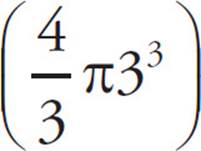 , which is equal to the target amount of 96π, so (B) is correct.
, which is equal to the target amount of 96π, so (B) is correct.
7. CWhenever there are variables in the question and in the answers, think Plugging In. Let c = 30. Therefore, b = 2 + ![]() (30) = 2 + 10 = 12. Plug 12 in for b in the answers to see which answer equals the target number of 30. Choice (A) becomes
(30) = 2 + 10 = 12. Plug 12 in for b in the answers to see which answer equals the target number of 30. Choice (A) becomes 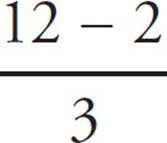 =
=  =
=  Eliminate (A), since it does not equal the target number. Choice (B) becomes
Eliminate (A), since it does not equal the target number. Choice (B) becomes 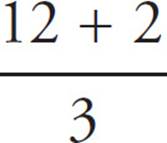 =
=  =
= ![]() Eliminate (B). Choice (C) becomes 3(12 − 2) = 3(10) = 30. Keep (C), but check (D) just in case it also works. Choice (D) becomes 3(12 − 6) = 3(6) = 18. Eliminate (D). The correct answer is (C).
Eliminate (B). Choice (C) becomes 3(12 − 2) = 3(10) = 30. Keep (C), but check (D) just in case it also works. Choice (D) becomes 3(12 − 6) = 3(6) = 18. Eliminate (D). The correct answer is (C).
8. DTreat this question as a translation problem. According to the question, R(h) = four rotations per second less than three times the square of the height of the liquid. The height of the liquid is represented by h. Therefore, three times the square of the height of the liquid = 3h2. Four less than this amount is 3h2 − 4. Since the original speed was 1,000, subtract this value from 1,000 to get the current rate of rotation. The correct answer is (D).
9. BStart with the easier equation and use Process of Elimination. The easier equation is related to the total number of ounces, c + b, in the tube. According to the question, the tube has 24 ounces, so c + b= 24. Eliminate (A), since it does not include this equation. The other equation in the set is related to the amount of active ingredients. According to the question, c includes 0.25% of sodium fluoride and b contains 0.30% triclosan. 0.25% = 0.0025 and 0.30% = 0.003. Therefore, in the correct equation, c should be associated with 0.0025 and b should be associated with 0.003. Eliminate (C) and (D) because both of these equations get the percentages wrong. The correct answer is (B).
10. CWhenever the question includes variables and the answer choices are numbers, think Plugging In the Answers. In (A), d = −4, and the equation becomes  . Solve both sides of the equation to get
. Solve both sides of the equation to get  , or
, or  =
=  . Reduce both fractions to get −13 = −5. This is not true, so eliminate (A). In (B), d = 2, and the equation becomes
. Reduce both fractions to get −13 = −5. This is not true, so eliminate (A). In (B), d = 2, and the equation becomes  . Solve both sides of the equation to get
. Solve both sides of the equation to get  , or
, or  =
=  . Reduce both fractions to get
. Reduce both fractions to get  =
= ![]() . Eliminate (B). In (C), d = 4 and the equation becomes
. Eliminate (B). In (C), d = 4 and the equation becomes  . Solve both sides of the equation to get
. Solve both sides of the equation to get  , or
, or  =
= ![]() . Reduce both fractions to get
. Reduce both fractions to get ![]() =
= ![]() . The correct answer is (C).
. The correct answer is (C).
11. DAll the answer choices are equal to 4 (which is r2, making r = 2), so you need to focus on where the center of the circle lies. If the circle is tangent to both the x axis (which is equivalent to the line y = 0) and the line x = 4, then the center must be 2 units from y = 0 and 2 units from x = 4. Choices (A) and (B) both have centers with an x value of −2 (remember the standard form of the circle equation is (x − h)2 + (y − k)2 = r2, where (h, k) is the center and r is the radius), which is 6 units from x = 4. Eliminate (A) and (B). Choice (C) has a center at (2, −4). The x value is 2 units from x = 4; however, the y value is 4 units from y = 0. Eliminate (C) and choose (D).
12. BAccording to the question, Reactant A does not react unless B gets to a certain concentration. Therefore, the correct answer will have an initial flat line for A while the line for B is rising. Only graph (B) shows this initial relationship. Therefore, the correct answer is (B).
13. AAll of the answers have the same lines graphed, so this question is really about the shading. Plugging In is probably the easiest way to approach this problem. Start with (0, 0) because this is an easy value to check. This works in all three equations since 0 ≤ 8, −3 ≤ 0, and 1 ≥ 0. Therefore, this value needs to be shaded as a possible answer. Eliminate (B), (C), and (D) because they do not include this point. The correct answer is (A).
14. CFirst draw lines AC and BD. Now, since tangent is opposite over adjacent,  =
= ![]() . Also, BA × BC = 324. Using these two equations as a system of equations can now help get what is needed. Rearrange the first equation by multiplying both sides by BC to get BA =
. Also, BA × BC = 324. Using these two equations as a system of equations can now help get what is needed. Rearrange the first equation by multiplying both sides by BC to get BA = ![]() BC. Now substitute
BC. Now substitute ![]() BC into the first equation to get
BC into the first equation to get ![]() BC (BC) = 324; this simplifies to
BC (BC) = 324; this simplifies to ![]() BC 2 = 324. Multiply both sides by (
BC 2 = 324. Multiply both sides by (![]() ) to get BC 2 = 729, and then take the square root to get BC = 27. Since the diagonal has to be larger than any of the sides, (A) and (B) are out. Choice (D) can also be eliminated because our previous calculations can get the length of DC, which is used in the Pythagorean theorem to get BD. Therefore, the correct answer is (C).
) to get BC 2 = 729, and then take the square root to get BC = 27. Since the diagonal has to be larger than any of the sides, (A) and (B) are out. Choice (D) can also be eliminated because our previous calculations can get the length of DC, which is used in the Pythagorean theorem to get BD. Therefore, the correct answer is (C).
15. DWhenever there are variables in the question and answers, think Plugging In. If m = 2, the expression becomes  = − 4. Plug 2 in for m in the answers to see which answer equals the target number of −4. Choice (A) becomes
= − 4. Plug 2 in for m in the answers to see which answer equals the target number of −4. Choice (A) becomes  = − 2.8. This does not match the target number, so eliminate (A). Choice (B) becomes
= − 2.8. This does not match the target number, so eliminate (A). Choice (B) becomes  . Eliminate (B). Choice (C) becomes
. Eliminate (B). Choice (C) becomes 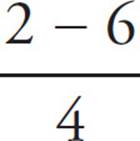 =
=  = −1. Eliminate (C). Choice (D) becomes m − 6 = 2 − 6 = −4. The correct answer is (D).
= −1. Eliminate (C). Choice (D) becomes m − 6 = 2 − 6 = −4. The correct answer is (D).
16. 1.5or ![]()
Plug the given values into the equation: 18 = (3)(4)(x). Multiply the right side of the equation and you find that 18 = 12x. Divide both sides by 12 and you find that x = ![]() . Both 18 and 12 are divisible by 6, so this fraction reduces to
. Both 18 and 12 are divisible by 6, so this fraction reduces to ![]() .
.
17. 53Jean charges 5.50 × 2 = $11 per hour for babysitting. Therefore, her entire earnings for three hours can be calculated as (3 × 11) + 20 = 53. The correct answer is 53.
18. 10To solve the problem without a graphing calculator, set the two equations equal to each other: −x2 + 5x + 6 = x + 12. Multiply the entire equation by 2 to get −2x2 + 10x + 12 = −x + 24. Rewrite the equation so that it equals 0, so it becomes −2x2 + 11x − 12 = 0. Multiply the entire equation by −1 to get 2x2 − 11x + 12 = 0. Factor the quadratic to get (2x − 3)(x − 4) = 0. Solve for the two possible values of x: If 2x − 3 = 0, then x = ![]() , and if x − 4 = 0, then x = 4. Because the slope of the line is negative, the x-value of the point that is farthest to the right along the x-axis must also be closer to the x-axis. Plug 4 in for x in the second equation to get y = −
, and if x − 4 = 0, then x = 4. Because the slope of the line is negative, the x-value of the point that is farthest to the right along the x-axis must also be closer to the x-axis. Plug 4 in for x in the second equation to get y = −![]() (4) + 12 = − 2 + 12 = 10. The correct answer is 10.
(4) + 12 = − 2 + 12 = 10. The correct answer is 10.
19.  or 3.66 or 3.67
or 3.66 or 3.67
Whenever there are two equations with the same two variables, they can be solved simultaneously by adding or subtracting them. Take the second equation and rewrite it so that the variables are on the left side of the equation: 17r + 22v = 63. Stack the equations and add them together.

Divide the entire equation by 30 to get r + v =  . This is too big to grid in, so reduce it to
. This is too big to grid in, so reduce it to ![]() .
.
20. 2The area of the current plot is 4 × 6 = 24 square feet, so the new plot will be 24 × 2 = 48 square feet. According to the question, x feet will be added to each side to obtain the new area of 48 feet. Since the length is only 2 feet more than the width, you need two factors of 48 that differ by 2. You may recognize these factors are 6 and 8. So the increase was 2 feet in each direction. Alternatively, you could write a quadratic: (4 + x)(6 + x) = 48. Expand the right side of the equation to get x2 + 10x + 24 = 48. Set the equation to 0 by subtracting 48 from both sides to get x2 + 10x − 24 = 0. Factor the equation to get (x + 12)(x − 2) = 0. Therefore, x = −12 or x = 2. Since lengths can never be negative the only possible value is x = 2. The correct answer is 2.
Section 4: Math (Calculator)
1. CUse Process of Elimination to answer this question. According to the question, P represents the population, so the outcome of the entire equation has something to do with the population. Therefore, eliminate both (A) and (B) because 1.0635 can’t represent the population if P does. In the equation given, the only operations are multiplication and addition, which means that over time the population would increase. Therefore, eliminate (D). The correct answer is (C).
2. BTo solve the quadratic equation, first set the equation equal to 0. The equation becomes x2 + 12x − 64 = 0. Next, factor the equation to get (x + 16)(x − 4) = 0. Therefore, the two possible solutions for the quadratic equation are x + 16 = 0 and x − 4 = 0, so x = −16 or 4. Since the question states that x > 0, x = 4 is the only possible solution. Another way to approach this question is to plug in the answers. Start with (B), x = 4. Plug 4 into the equation to get 42 + 12(4) = 64. Solve the left side of the equation to get 16 + 48 = 64, or 64 = 64. Since this is a true statement, the correct answer is (B).
3. ATo figure out the total number of shelving units Sai could use, find the total available wall space and divide by the length of the units. The total amount of wall space can be calculated as 119 – 21. Because the length of each unit is 7 feet, the maximum number of units Sai could put up can be calculated as 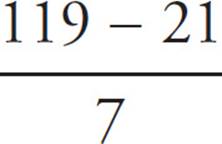 . Because this is the maximum number of units Sai could put up, r has to be less than or equal to this number. Therefore, the correct answer is (A).
. Because this is the maximum number of units Sai could put up, r has to be less than or equal to this number. Therefore, the correct answer is (A).
4. CWeight is shown on the vertical axis of the graph, given in ounces. Make your own mark indicating 5.75 on this axis; then draw a horizontal line from that mark to the line of best fit. Once you hit it, draw a vertical line straight down to the horizontal axis. It should hit between 75 and 80 days, slightly closer to the mark for 75. This makes (C) the credited response. Draw your lines carefully, using your answer sheet as a straightedge if necessary.
5. CWhenever the question includes variables, plug in. If s = 2, the shirts cost 2($24.50) = $49. The tax on the shirts is 0.07($49) = $3.43. So, the shirts with tax and the $6 shipping fee cost $49 + $3.43 + $6 = $58.43. Plug in 2 for s in the answers to see which answer equals the target number of $58.43. In (A), 0.07[24.50(2) + 6] = 3.85. This is not the target number, so eliminate (A). In (B), 1.07(24.50 + 6)(2) = 65.25. Again, this is not the target number, so eliminate (B). In (C), 1.07[24.50(2)] + 6 = 58.43. This is the target number, so keep it, but be sure to check the remaining answer choice. In (D), 1.07(24.50 + 2) + 6 = 34.355, which is not the target number. Therefore, the correct answer is (C).
6. BThe question states that after 6 weeks the plant is 54 centimeters tall. Therefore, when w = 6, h(w) = 54. Plug in 6 for w in the answers to see in which answer h(w) equals the target number of 54. In (A) h(w) = 6(6) = 36. Eliminate (A). In (B), h(w) = 9(6) = 54. The correct answer is (B).
7. DBecause the operation between the parentheses is addition, the parentheses can be removed, and the resulting expression becomes 12x2 + 4x + 5y + 3x2 − 2x + 3y. Reorder the terms so that like terms are next to each other: 12x2 + 3x2 + 4x − 2x + 5y + 3y. Combine like terms to get 15x2 + 2x + 8y. The correct answer is (D).
8. DYou do not know how the survey is conducted, nor do you know how many veterinarians were surveyed (it may be the case that only 8 were surveyed). Therefore, you cannot infer that the survey accurately measures all veterinarians’ beliefs about Royal Rat Rations. Choice (A) is not supported. First, you do not know what veterinarians believe in general, and second veterinarians may be recommending Royal Rat Rations for a reason other than its nutrition. Choice (B) is similarly not supported. Besides not knowing veterinarians’ beliefs, this choice assumes that no other rat food is acceptable. Choice (C) is not supported because you do not know the sample size of the survey, nor is there any indication that there is only one veterinarian who does not recommend Royal Rat Rations. Choice (D) is the credited response. You know the opinions only of the veterinarians surveyed by Royal Rat Rations.
9. DUse a calculator to translate the fractions into decimals. ![]() t + 4 =
t + 4 = ![]() t − 5 becomes 0.5t + 4 = 0.75t − 5. Subtract 0.5t from both sides to get 4 = 0.25t − 5, and then add 5 to both sides. This results in 9 = 0.25t. Use a calculator to divide! t = 36; therefore, the correct answer is (D).
t − 5 becomes 0.5t + 4 = 0.75t − 5. Subtract 0.5t from both sides to get 4 = 0.25t − 5, and then add 5 to both sides. This results in 9 = 0.25t. Use a calculator to divide! t = 36; therefore, the correct answer is (D).
10. CTaking the two dogs together, Everett has 35 + 55 = 90 pounds of dog. Set up the following proportion to determine the lowest amount of water the dogs need per day:  . Cross-multiply to get 10x = 765, so x = 76.5. Multiply by 7 days to get the weekly amount of water the dogs need: 76.5 × 7 = 535.5 ounces, or approximately 536 ounces. Only (C) includes 536 as the low-end amount. Therefore, the correct answer is (C).
. Cross-multiply to get 10x = 765, so x = 76.5. Multiply by 7 days to get the weekly amount of water the dogs need: 76.5 × 7 = 535.5 ounces, or approximately 536 ounces. Only (C) includes 536 as the low-end amount. Therefore, the correct answer is (C).
11. AIn order to answer this question, you need to deal with the ratio as well as the unit conversion. For the large batch of dry rub, Priya’s friend is planning to use 91 ounces of chili powder. Since the paprika and the chili powder must be used in a ratio of 4 to 7, you can set up a proportion to determine how much paprika is needed: ![]() =
=  . Cross-multiply and solve for x to determine that x (i.e., paprika) = 52 ounces. So you have 52 ounces of paprika and 91 ounces of chili powder for a total of 143 ounces. Multiply that by your conversion number, 28.3, to determine that this is equivalent to 4,046.9 grams, which is closest to (A).
. Cross-multiply and solve for x to determine that x (i.e., paprika) = 52 ounces. So you have 52 ounces of paprika and 91 ounces of chili powder for a total of 143 ounces. Multiply that by your conversion number, 28.3, to determine that this is equivalent to 4,046.9 grams, which is closest to (A).
12. DWhenever there are variables in the problem and in the answer choices, plug in. If w = 20, then Luciano’s cup has 20 − 2 = 18 ounces at the end of day 1. At the end of 7 days, Luciano’s cup would have 18 − 8 = 10 ounces. After 11 days, Luciano’s cup would hold 10 − 5 = 5 ounces. Plug in 20 for w in the answer choices to see which answer is equal to the target number of 5. Choice (A) becomes 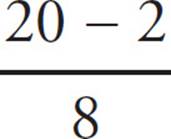 =
=  = 2.25. This does not match the target number of 5, so eliminate (A). Choice (B) becomes
= 2.25. This does not match the target number of 5, so eliminate (A). Choice (B) becomes 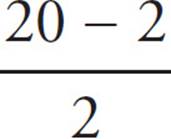 − 10 =
− 10 =  − 10 = 9 − 10 = − 1. Eliminate (B). Choice (C) becomes
− 10 = 9 − 10 = − 1. Eliminate (B). Choice (C) becomes 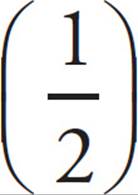 (20) − 10 = 10 − 10 = 0. Eliminate (C). Choice (D) becomes
(20) − 10 = 10 − 10 = 0. Eliminate (C). Choice (D) becomes 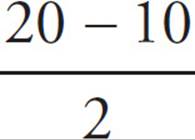 =
=  = 5. This matches the target number; therefore, the correct answer is (D).
= 5. This matches the target number; therefore, the correct answer is (D).
13. BAccording to the line of best fit, in 1995 there were 20 coyotes in the park. In 2000, there were 140 coyotes in the park. This is an increase of 120 coyotes over a period of 5 years, so  = an average increase of 24 coyotes per year, which is (B).
= an average increase of 24 coyotes per year, which is (B).
14. DThe median number of coyotes in the park in 1995 was 20, and the median number of coyotes in the park in 1996 was 60. (Be careful to RTFQ: the question wants median, NOT line of best fit!) In order to calculate the percent increase, it is necessary to use the percent change formula: 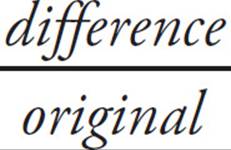 × 100. The calculation here will be
× 100. The calculation here will be 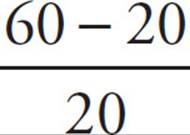 × 100 =
× 100 =  × 100 = 2 × 100 = 200%, which is (D).
× 100 = 2 × 100 = 200%, which is (D).
15. AStart with the easier equation and use Process of Elimination. The easier equation is related to the total number of shirts and pants, s + p, sold on a regular day. The question states that on a regular day Bailey’s sells ![]() the number of pants and shirts sold during a sale.
the number of pants and shirts sold during a sale. ![]() (60) = 40. Therefore, one of the equations in the correct answer should be s + p = 40. Eliminate (C) and (D) since neither of these answers include this equation. The other equation is related to the money Bailey’s earns on a regular day. According to the question, Bailey’s earns a total of $1,875 on a regular day, so the equation must equal $1,875. Eliminate (B) because the total in the money equation is incorrect. The correct answer is (A).
(60) = 40. Therefore, one of the equations in the correct answer should be s + p = 40. Eliminate (C) and (D) since neither of these answers include this equation. The other equation is related to the money Bailey’s earns on a regular day. According to the question, Bailey’s earns a total of $1,875 on a regular day, so the equation must equal $1,875. Eliminate (B) because the total in the money equation is incorrect. The correct answer is (A).
16. CThere are a few different ways to approach this question. In any approach, the best first step is to figure out how much income Bryan earned during the two-week period without the commission. Since he worked an average of 35 hours per week for two weeks, he worked a total of 70 hours. At a rate of $10.00 per hour base pay, this would add up to $700.00 (70 × 10 = 700). Since Bryan’s earnings were actually $850.00, that means he must have earned $150.00 of commission (850 − 700 = 150). At this point, you can calculate the percent commission algebraically or simply work backwards from the answers. Algebraically, you know that $150.00 is equal to a certain percent of $5,000.00 in sales, which can be represented as follows: 150 = 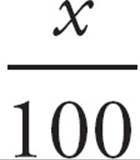 (5,000). Solve for x, and you get 3, which is (C). If instead you wish to work backwards from the answers, you can take the answers and calculate what 1%, 2%, etc. of $5,000.00 would be, and then add that back to $700.00 to see which choice matches your target of $850.00: (C).
(5,000). Solve for x, and you get 3, which is (C). If instead you wish to work backwards from the answers, you can take the answers and calculate what 1%, 2%, etc. of $5,000.00 would be, and then add that back to $700.00 to see which choice matches your target of $850.00: (C).
17. CCross-multiply to get 3(C + x) = (x − 3)(x + 8). Expand the right side of the equation to get 3(C + x) = x2 + 5x − 24. Distribute the 3 to get 3C + 3x = x2 + 5x − 24. Subtract 3x from both sides of the equation to get 3C = x2 + 2x − 24. Factor the right side of the equation to get 3C = (x + 6)(x − 4). Divide both sides by 3 to get C = 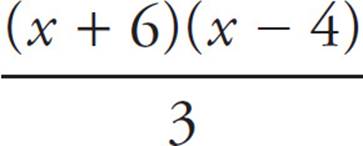 =
= ![]() (x + 6)(x − 4). The correct answer is (C).
(x + 6)(x − 4). The correct answer is (C).
18. AStart with the easiest piece of information first, and use Process of Elimination. Given that h is the number of hours spent hiking and d is the number of hours driving, the total number of hours Lennon spends in the park can be calculated as h + d. The question states that Lennon has up to 6 hours to spend in the park—“up to” means ≤. So, h + d ≤ 6. Eliminate (B), (C), and (D). The correct answer is (A).
19. BThe quality control expert discovered that 13 out of 1,000 randomly selected tennis balls were defective. 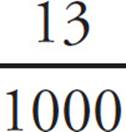 = 0.013, which is equivalent to 1.3%. This means that 100 − 1.3 = 98.7% of tennis balls tested were not defective, and this data most supports answer (B).
= 0.013, which is equivalent to 1.3%. This means that 100 − 1.3 = 98.7% of tennis balls tested were not defective, and this data most supports answer (B).
20. CWhen solving inequalities, the natural impulse is to isolate the variable. In this case, though, look at what the question is asking. The question doesn’t want you to find just the the value of z but rather the value of 9z − 18. To get from the value of −3z + 6 given in the inequality to this new value, the original inequality must be multiplied by −3. Just multiply the entire inequality by this value, making sure to flip the inequality signs when multiplying by a negative number. The equation becomes −3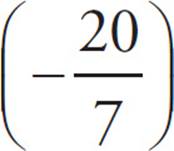 > −3(−3z + 6) > −3
> −3(−3z + 6) > −3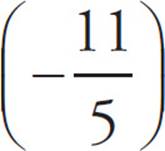 or
or  > 9z − 18 >
> 9z − 18 >  . The question asks for the greatest possible integer value, so focus on the high end of the given values. The value at that end,
. The question asks for the greatest possible integer value, so focus on the high end of the given values. The value at that end,  , equals 8.57, so the greatest integer less than that is 8. The answer is (C).
, equals 8.57, so the greatest integer less than that is 8. The answer is (C).
21. AWhenever there are variables in the question and numbers in the answer choices, think Plugging In the Answers. In (A), j = 6, and k = −6. Plug these two values into the first equation to get −24 − 8(6) = 12(−6). Solve for both sides of the equation to get −24 − 48 = −72, or −72 = −72. Therefore, the values work for the first equation. Plug the values into the second equation to get 3 + ![]() (−6) = −
(−6) = −![]() (6). Solve both sides of the equation to get 3 + (−10) = −7, or −7 = −7. Since the values given in (A) work in both equations, the correct answer is (A).
(6). Solve both sides of the equation to get 3 + (−10) = −7, or −7 = −7. Since the values given in (A) work in both equations, the correct answer is (A).
22. CFirst, you know the new proportion must be less than the current 0.34 for biofuels (because the total amount spent on alternative energy is increasing, but the amount spent on biofuels is remaining the same), so you can eliminate (D). Next, determine the amount that will be spent on biofuels in 2017 by multiplying 0.34 by the total of $254 million: 0.34 × 254 = $86.36 million. Because 57 million new dollars will be spent on alternative energy, the new total will be 254 + 57 = $311 million. Divide $86.36 million by $311 million to get the new proportion: 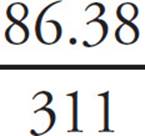 = 0.28, which is (C).
= 0.28, which is (C).
23. DIn quadrant II, the x-coordinate is negative, and the y-coordinate is positive. Therefore, eliminate (C). Whenever the question includes variables and the answers are numbers, think Plugging In the Answers. Of the remaining answers, (B) is easiest to work with. In (B), the x-value is −4 and the y-value is 2. Plug these values into the second equation to get −4 = −2 + 2. Given that this is not a true statement, eliminate (B). Try the values in (A) in the second equation to get 3 = −(−3
= −(−3 ) + 2. This is also not true, so the correct answer is (D).
) + 2. This is also not true, so the correct answer is (D).
24. BRight away, (A) can be eliminated, since point C has a negative y-coordinate. Given any two points, the slope of the line can be determined using the equation 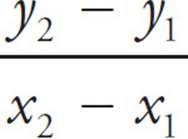 . Use this formula to find the value of b by setting the slope of
. Use this formula to find the value of b by setting the slope of ![]() equal to the slope of
equal to the slope of ![]() Use points (0, 3) and (5b, b) in the left side of the equation and points (5b, b) and (10b, −b) in the right side of the equation to get
Use points (0, 3) and (5b, b) in the left side of the equation and points (5b, b) and (10b, −b) in the right side of the equation to get  . Simplify both sides of the equation to get
. Simplify both sides of the equation to get 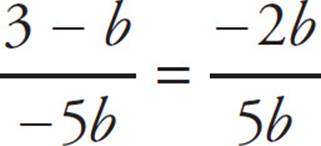 , or
, or 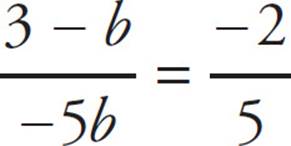 . Cross-multiply to get 5(3 − b) = 10b. Divide both sides by 5 get 3 − b = 2b, then 3 = 3b, and finally b = 1. Plug in b =1 for point C to get [10(1), − (1)], or (10, −1). Therefore, the correct answer is (B).
. Cross-multiply to get 5(3 − b) = 10b. Divide both sides by 5 get 3 − b = 2b, then 3 = 3b, and finally b = 1. Plug in b =1 for point C to get [10(1), − (1)], or (10, −1). Therefore, the correct answer is (B).
25. AThe formula for compound interest is A = P(1 + r)t, where P is the starting principle, r is the rate expressed as a decimal, and t is the number of times the interest is compounded. Melanie received less than 5% interest, so you can eliminate (B) because 1.05 = 1 + 0.05, indicating she was receiving 5% interest. You can also eliminate (C) because over the course of a year the interest is compounded 4 times, not ![]() of a time. Because Melanie invested $1,100 at what she thought was 5% compounded 4 times (12 months in a year ÷ 3 months per period), she expected 1,100(1 + 0.05)4 = $1,337.06 after a year. Instead, she has 1,337.06 − 50 = $1,287.06 after one year. Because t is in years in the answer choices, make t = 1 in (A) and (D) and eliminate any choice which does not equal 1,287.06. Only (A) works.
of a time. Because Melanie invested $1,100 at what she thought was 5% compounded 4 times (12 months in a year ÷ 3 months per period), she expected 1,100(1 + 0.05)4 = $1,337.06 after a year. Instead, she has 1,337.06 − 50 = $1,287.06 after one year. Because t is in years in the answer choices, make t = 1 in (A) and (D) and eliminate any choice which does not equal 1,287.06. Only (A) works.
26. BYou can start by Plugging In a value for x; try x = 4. Because angle AOB is 120° and the triangle is isosceles, angles A and B are each 30°. Cut triangle AOB in half to make two 30-60-90 triangles with a hypotenuse of 4 and sides of 2 and 2 . The side with length 2
. The side with length 2 lies on chord AB. Double it to get the total length: 4
lies on chord AB. Double it to get the total length: 4 or just
or just  x, which is (B) when you put x = 4 into the answer choices.
x, which is (B) when you put x = 4 into the answer choices.
27. CWhenever there are variables in the question and in the answers, think Plugging In. The question states the value of g, but it is a constant and a weird one at that. Pick numbers for all the variables that will make the math more straightforward. If v = 4 and g = 2, then  , and
, and  . Plug these values into the answers to see which equation works. Choice (A) becomes
. Plug these values into the answers to see which equation works. Choice (A) becomes  . Simplify the right side of the equation to get
. Simplify the right side of the equation to get  , or
, or 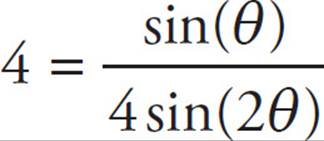 . This will not simplify further, so eliminate (A). Choice (B) becomes
. This will not simplify further, so eliminate (A). Choice (B) becomes  . Simplify the right side of the equation to get
. Simplify the right side of the equation to get  or
or 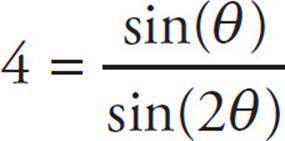 . Eliminate (B). Choice (C) becomes
. Eliminate (B). Choice (C) becomes  . Distribute the 2 to get
. Distribute the 2 to get  . Reduce the equation to get or 4 =
. Reduce the equation to get or 4 =  or 4 = 4. The correct answer is (C).
or 4 = 4. The correct answer is (C).
28. Dia = 1 when a is a multiple of 4. Using your exponents rules, 413 + x must also be a multiple of 4. Plug in the answers and look for what makes 413 + x a multiple of 4. Only (D) works.
29. CThe zero of g is the value of the variable, in this case x, when the equation is set to 0. This is also called the root or solution of an equation. Set the equation to 0 to get 0 = 2x2 − dx − 6. Plug 6 in for x to get 0 = 2(62) − d(6) − 6. Simplify the equation to get 0 = 72 − 6d − 6, or 0 = 66 − 6d. Solve for d to get −66 = −6d, so 11 = d. Plug 11 in for d and set the quadratic to 0 to get 0 = 2x2 − 11x − 6. Factor the equation to get 0 = (x − 6)(2x + 1). The other zero of the equation is when 2x + 1 = 0. Solve for x to get 2x = −1, or x =  . The correct answer is (C).
. The correct answer is (C).
30. DThe flu shot is most effective against Strain C, which is least prevalent in March. To determine the overall efficacy of the flu shot at this time, multiply the prevalence of each strain of flu by the efficacy of the flu shot against that strain, and then add those products to get a weighted average of the efficacy of the shot: (0.23 × 0.35) + (0.25 × 0.13) + (0.13 × 0.76) + (0.39 × 0.68) = 0.477 = 47.7%, which is closest to (D).
31. 3Solve the equation for v. Take 9 > 3v − 3 and add 3 to both sides to get 12 > 3v. Now divide both sides by 3 to find that 4 > v. Therefore, the largest integer that v could be is 3. Grid in 3.
32. ![]() or 0.83
or 0.83
Start by multiplying the second fraction in the denominator of the equation by ![]() to get
to get 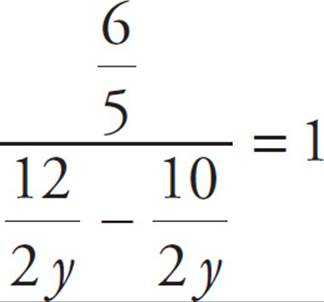 . Combine the fractions in the denominator to get
. Combine the fractions in the denominator to get 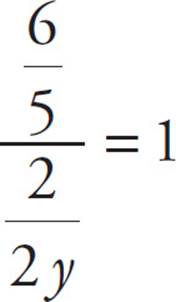 . Reduce the fraction in the denominator to get
. Reduce the fraction in the denominator to get 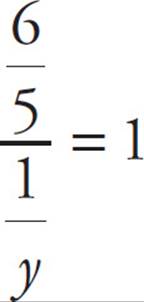 . Dividing by a number is the same as multiplying by its reciprocal, so the equation becomes
. Dividing by a number is the same as multiplying by its reciprocal, so the equation becomes ![]() × y = 1. Multiply both side of the equation by
× y = 1. Multiply both side of the equation by ![]() to get y =
to get y = ![]() . The correct answer is
. The correct answer is ![]() .
.
33. 1,279614 students voting for Candidate A represents 0.48 of the population out of 1. Set up a proportion:  , where x is the total number of students in the school. Cross-multiply: 0.48x = 614. Divide both sides by 0.48 and you get approximately 1,279.
, where x is the total number of students in the school. Cross-multiply: 0.48x = 614. Divide both sides by 0.48 and you get approximately 1,279.
34. or 0.384 or 0.385
or 0.384 or 0.385
Draw a right triangle and label a non-right angle θ. SOHCAHTOA tells you that tangent is 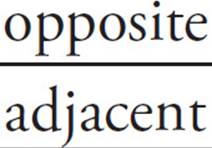 , so the leg opposite θ is 12 and the leg adjacent to θ is 5. Cosine is
, so the leg opposite θ is 12 and the leg adjacent to θ is 5. Cosine is 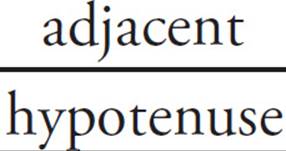 , so you need to find the hypotenuse of the triangle. You can use the Pythagorean theorem, or you can recognize this as a 5-12-13 Pythagorean triplet. The hypotenuse is therefore 13. The leg adjacent to θ is still 5, so cos θ=
, so you need to find the hypotenuse of the triangle. You can use the Pythagorean theorem, or you can recognize this as a 5-12-13 Pythagorean triplet. The hypotenuse is therefore 13. The leg adjacent to θ is still 5, so cos θ=  .
.
35. 7,054First, you need to determine the current exchange rate. The 7% fee is the same (relative to the exchange rate), whether it was applied to the Cedi or USD. Therefore, 7% of 651 Cedi is equal to 32.30 USD. Translate English to math: 0.07(651) = 32.30, or 45.57 Cedi = 32.30 USD. Next, you want the value of an item worth 5,000 USD in Cedi, so set up a proportion:  . Cross-multiply: (45.57)(5,000) = 32.30x, or 227,850 = 32.30x. Divide both sides by 32.30 and you get x = 7,054.18 USD, which rounds to 7,054.
. Cross-multiply: (45.57)(5,000) = 32.30x, or 227,850 = 32.30x. Divide both sides by 32.30 and you get x = 7,054.18 USD, which rounds to 7,054.
36. 63.6 or 63.7
First, draw a square inscribed in a circle. Because the diameter of the circle is equal to the diagonal of the square, you can plug in a number like 2 for the length of the diameter. Because the diameter forms a 45⁰-45⁰-90⁰ triangle, each side of the square has a length of 2. Using the area formula for a square (A = s2), plug in 2 for the s to get A = 22, which simplifies to A = 4. The area of the square is 4. To find the area of the circle, use the formula A = πr2. Because the diameter of the circle is 2
for the length of the diameter. Because the diameter forms a 45⁰-45⁰-90⁰ triangle, each side of the square has a length of 2. Using the area formula for a square (A = s2), plug in 2 for the s to get A = 22, which simplifies to A = 4. The area of the square is 4. To find the area of the circle, use the formula A = πr2. Because the diameter of the circle is 2 , r =
, r =  . Plug that into the area formula to see that A = π(
. Plug that into the area formula to see that A = π( )2, which simplifies to become A= 2π. To find the solution to the problem, translate what you are being asked from English into math. The area of the square is what percent of the area of the circle becomes: 4 =
)2, which simplifies to become A= 2π. To find the solution to the problem, translate what you are being asked from English into math. The area of the square is what percent of the area of the circle becomes: 4 = 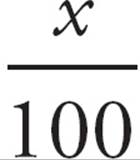 2π. Solve for x: First, divide each side by 2π, and then multiply each side by 100. The answer is a non-repeating decimal beginning 63.66197…When entering your answer, simply cut off the decimal (do not round) so it takes up four spaces. You should enter 63.6.
2π. Solve for x: First, divide each side by 2π, and then multiply each side by 100. The answer is a non-repeating decimal beginning 63.66197…When entering your answer, simply cut off the decimal (do not round) so it takes up four spaces. You should enter 63.6.
37. or 0.7
or 0.7
If the mean of the new set is ![]() , then the sum of the diameters of the cylinders divided by the number of cylinders must equal
, then the sum of the diameters of the cylinders divided by the number of cylinders must equal ![]() . Set up the equation:
. Set up the equation: ![]() =
= 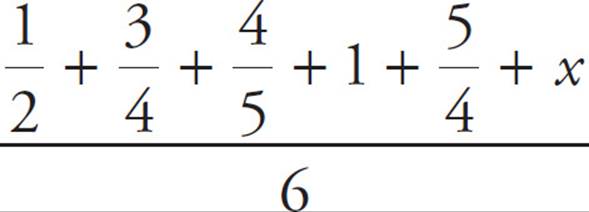 , where x is the unknown cylinder. Multiply both sides by 6 to simplify: 5 =
, where x is the unknown cylinder. Multiply both sides by 6 to simplify: 5 = ![]() +
+ ![]() +
+ ![]() + 1 +
+ 1 + ![]() + x. Combine like terms (use your calculator, but be careful with parentheses!): 5 =
+ x. Combine like terms (use your calculator, but be careful with parentheses!): 5 =  + x. Subtract
+ x. Subtract  from both sides and you get
from both sides and you get  .
.
38.1 ≤ y ≤ 1.25
A set with an even number of elements will have as its median the average of the middle two terms. In the current set, ![]() and 1 have an average of
and 1 have an average of  , so the new cylinder must be equal to or greater than 1, so the median will be the average of
, so the new cylinder must be equal to or greater than 1, so the median will be the average of ![]() and 1. The range of the set of five cylinders is the greatest minus the least:
and 1. The range of the set of five cylinders is the greatest minus the least: ![]() −
− ![]() =
= ![]() . Because the new cylinder must be
. Because the new cylinder must be ![]() inches to
inches to ![]() greater than
greater than ![]() , the cylinder must be between 1 and
, the cylinder must be between 1 and ![]() inches in diameter.
inches in diameter.